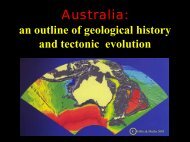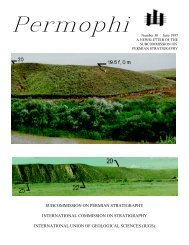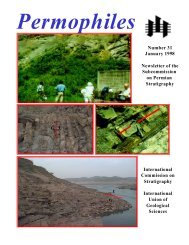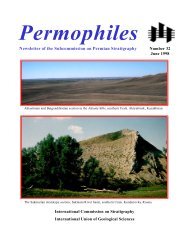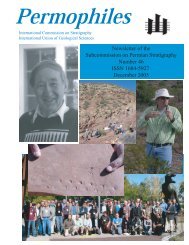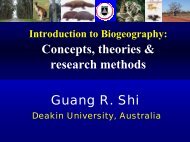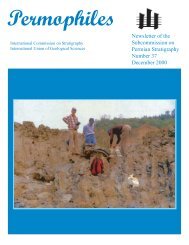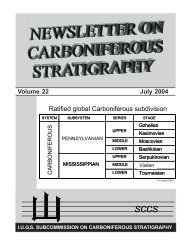Permophiles
Permophiles
Permophiles
You also want an ePaper? Increase the reach of your titles
YUMPU automatically turns print PDFs into web optimized ePapers that Google loves.
Remarks. Up to the present day the most ancient find of the truepeltasperms with radially symmetrical seed-bearing discs wasPeltaspermum retensorium (Zalessky) Naugolnykh and Kerp 1986.This species is characteristic for Kungurian and, probably,Artinskian of the Middle and Southern Urals. However, sterile leavesof callipterids, very similar to the fronds of P. retensorium are widelyspread in considerably older deposits of Northern hemisphere, e.g. Rotliegend of Europe and synchronous strata in North America,which are as old as Asselian and Sakmarian.It is assumed that the female generative organs Autuniamilleriensis Krasser are associated with these callipterid frondsthere (Kerp, 1982, 1988). Occasionally true peltoids (radially symmetricalovuliferous discs) are found together with typical callipteridfronds in Lower Permian (Asselian-Sakmarian) assemblages in Europeand northern part of Africa (Aassoumi, 1994), and CentralAsia (Bykovskaya, 1988, and personal communication).Our seed-bearing disc Peltaspermum sp. from the uppermostCarboniferous (Gzhelian) of the Cis-Urals most probably belongsto a peltaspermalean pteridosperm with callipterid foliage.Callipterids Callipteris conferta (Sternberg) Brongniart (Autuniaconferta sensu Kerp, 1988) and some other related species can befound rarely in the Upper Carboniferous of N. America (DunkardFormation) and Europe. The assignation of the sterile callipteridfronds from the Upper Carboniferous and Lower Permian of thenorthern hemisphere to Peltaspermales is quite realistic. Therefore,the paleontologically documented history of peltasperms, veryadvanced pteridosperms, or so-called “seed ferns” can be tracedinto the Late Carboniferous.Locality: Aidaralash, layer 17/2, Kazakhstan; Upper Gzhelian.Permotheca sp. (Fig. 1, B; Fig. 2, B). Male generative organ ofpteridosperm belonging to Peltaspermales. This remain is asynangium that consists of three preserved sporangia. Sporangiaare almost free and connected by their margins only at their basalparts. Length of the sporangia is 5-6.5 mm; maximum width is 2 mm.Thus, the sporangia are relatively narrow, and they are different inthis character from other known Lower Permian representatives ofPermotheca. The sporangia are of prolonged elliptical form withslightly acute apexes. Maximal width is located near sporangialapex. Surface of the sporangia bears fine spiral ribs and furrows(axis of the spiral direction is long axis of the sporangium). Therelief of the sporangial surface is due to well developed spirallyarranged long epidermal cells, very typical for representatives ofPermotheca (see, for instance, Krassilov et al., 1999) and malefructifications of some other primitive gymnosperms (Arberiella).Besides the relief formed by the numbers of epidermal cells, thereare one or two wide and deep folds on each sporangium. Thesefolds probably correspond to sporangial opening for depollination.One can see an ovoid scar located at the base of the synangium.The regular form of the scar supports the idea it was formed byspecial layer of cells adopted for pollen sacs (sporangia) separation.Scar length is 2 mm, width – 1 mm. Similar scars of the attachmentof sporangial head (synangium) to the stalk of the fructification(male cone) were recorded for other peltasperms (i.e.,Peltaspermum retensorium; Naugolnykh, Kerp, 1996, fig. 7, A).<strong>Permophiles</strong> Issue #39 2001There is one male fructification, represented by one small fragment(Fig. 3, A). The fructification belongs to another type, and,most probably, of Trigonocarpalean affinity. Poor preservation ofthe fragment doesn’t allow this remain be studied properly.Additional observations on isolated seedsIsolated seeds of the localities studied (Aidaralash section)were briefly described and discussed in the previous report(Naugolnykh, 1999). During the last two years some new materialof this kind has appeared. New findings are preliminarily and characterizedbelow as three different morphotypes, without givingany Latin names.Morphotype 1 (Fig. 3, C). Platyspermic seeds of small size(from 4 up to 10 mm long) and rounded or elliptical outlines.Spermoderma smooth. Seed scarlet is located at the centre ofbasal (“ventral”) part of the seed. The scarlet is small, difficultlyobserved. The scarlet is slightly uplifted, sometimes can besurrounded by two narrow laminas (septa) located along themain plane of the seed. Two small wings are present. Theysymmetrically surround the micropyle.Remarks. Seeds of this kind were found in the Sakmarianonly, e.g. in Kozhim-1 locality (Pechora Cis-Urals, LowerKosjinskian Subsuite, Kosjinskian Suite) and in Kondurovkaand Sim localities. It is quite possible, that this distinctivemorphotype of the isolated seeds can be regarded as an indexfossilfor the Sakmarian of the Cis-Urals.Very similar seeds were described as Diceratosperma Andrews(1941) from the Lower Permian of the Northern America. Mostprobably, the American specimens of Diceratosperma and theseeds briefly characterized above can belong to one and the samegroup of gymnosperms. Andrews believed that Diceratospermabelonged to the plant with Dichophyllum Elias leaves. Very similarleaves are known from the Permian of the Cis-Urals, where theytraditionally attributed to Mauerites Zalessky (probably, oldersynonym of Dichophyllum).Locality: Aidaralash, layer 16/1, GzhelianMorphotype 2 (Fig. 3, B). Small seeds 3.5 mm long and 2 mmwide with ovoid outlines and acute prolonged micropylar part.The most completely preserved specimen is broken up along itsaxis, therefore some inner structures can be observed.The outermost layer is relatively thick (up to 0.7-0.8 mm) andshould be regarded as an integument. At the apical part of theseed the integument forms a tube-like structure. The next, innerstructure is separated from the integument by free space(“perinucellar space”). The structure is fusiform, with long,spine-like apex. Inside the apex the sagittal channel is located.This fusiform structure can be interpreted as a nucellus.There is one more inner structure inside the nucellus, disposedat the nucellus basal part. It has ovoid outlines and probablyis a megasporal membrane with embryonic tissue inside.A small band of conducting tissues goes into the basal partof the seed and forms the small halaza.Locality: “Sim”, Sim City, Bashkortostan, Russia; Upper Sakmarian.Locality: Aidaralash, layer 16/1, Gzhelian.20



